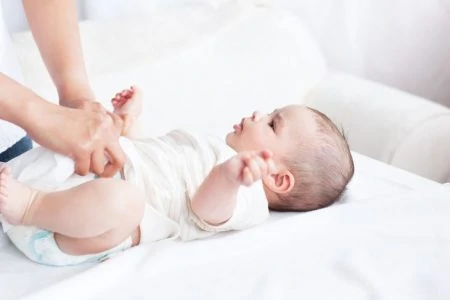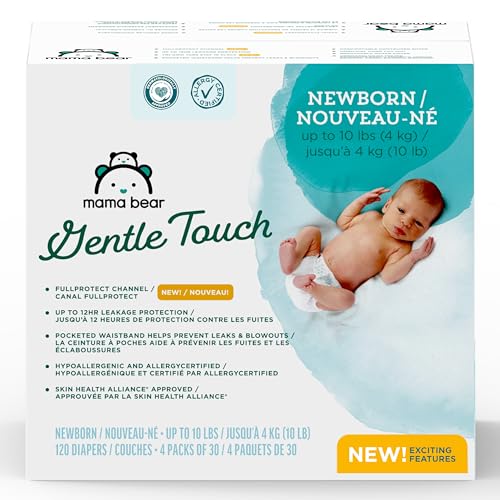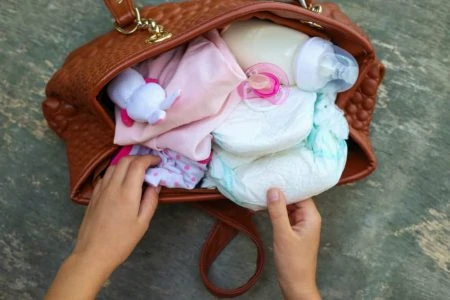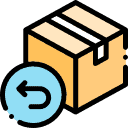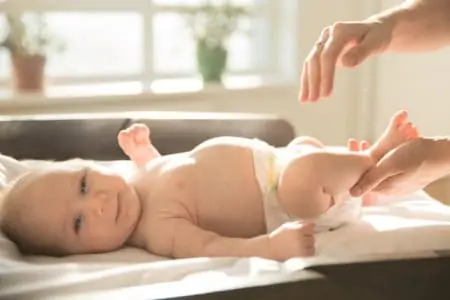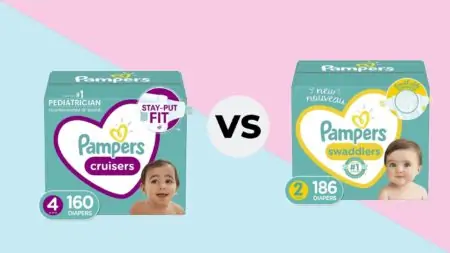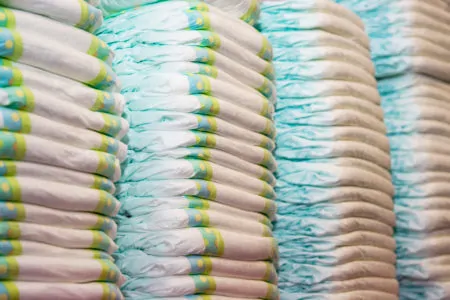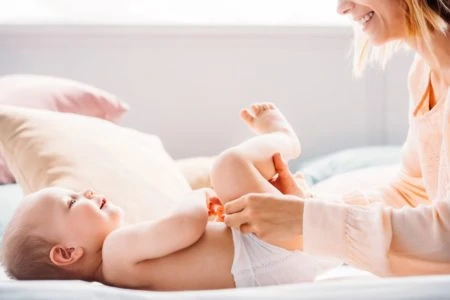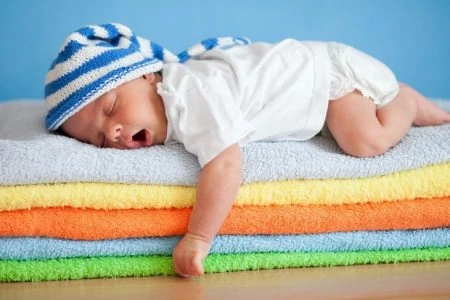Let’s be real: disposable diapers are a modern parenting miracle. They save you time, stress, and countless loads of laundry. You don’t have to worry about scooping poop, deep cleaning, or carrying around a wet bag of dirty cloth while you’re out and about.
But with aisles stocked floor-to-ceiling, picking the right pack is overwhelming. How do you find the best absorbency? What size does your baby actually need? And what on earth do you do about diaper rash?
We’re here to help you navigate the shelf. In this guide, we’ll tackle sizing, features, and common questions, followed by our top reviews to help you find the perfect fit for your baby’s bottom.
- Environment and baby skin friendly
- Provides ultimate hydration
- Form-fitting design
- Protects your baby’s belly button
- Quilted liners
- With wetness indicator strip
- High-quality diapers
- 20% off with Amazon Prime
- Hypoallergenic materials
- Umbilical cord cutout
- Impressive absorbency
- Hypoallergenic and chemical-free
- Clinically proven gentle on skin
- Soft quilted liner
- Absorbent, moisture-wicking core
- Uses organic plant-based materials
- Meets rigorous environmental standards
- Chemical-free
- Double grip strips
- Keeps baby dry and comfy
- Contoured fit allows flexibility
- Ultra absorbent, ultra-thin lining
- Eco-friendly, sustainable materials
- Contoured, stretchy design
- Helps prevent blowouts
- Easy to use and apply
- Made of comfy & safe materials
- Our Top Picks
- The Anatomy of a Disposable Diaper
- What About Eco-Friendly Disposable Diapers?
- Things to Consider
- Product Reviews
- How to Find the Right Size Diaper
- How to Save Money on Diapers
- How to Prevent Diaper Rash
- How to Dispose of Diapers Properly
- 3 Diapering Essentials You Need
- Disposable Diaper FAQs
- The Bottom Line
The Anatomy of a Disposable Diaper
Walk into any grocery store, and you’ll see walls of colorful boxes. While features vary by brand, almost every disposable diaper relies on the same basic construction.
Most are made from wearable plastics like polyesters or polyethylene. They use three distinct layers to keep your baby dry (1):
- Top Sheet: This is the inner lining that touches your baby’s skin. Many brands add a barrier ointment or lotion here to reduce friction and redness.
- Absorbent Inner Layer: This is the workhorse of the diaper. It typically contains super-absorbent polymers that can soak up to 30 times their own weight in fluid.
- Back Sheet: This is the waterproof outer layer. It prevents leaks from ruining clothes and helps wick away moisture from the core.
Some brands also add perfumes and dyes. If your little one has sensitive skin, double-check the label; these additives are common triggers for irritation.
What About Eco-Friendly Disposable Diapers?
If you want to go green, cloth diapers are the gold standard. However, “green” disposables have become a popular middle ground. They offer the convenience of a throw-away diaper with a reduced environmental impact.
While they look and work like traditional diapers, eco-friendly options differ in two main ways:
- Biodegradable Materials: These diapers utilize plant-based materials like corn, wheat, or bamboo instead of plastics, meaning they break down faster in landfills.
- Chemical Free: Most eco-friendly brands avoid harsh additives. You likely won’t find chlorine, latex, perfumes, or dyes in these packs.
If you are interested in eco-friendly disposable diapers, you have plenty of choices. They are now widely available in big-box stores and online.
Things to Consider
Every baby is unique; a brand that works for your neighbor might leak for you. It often takes a little trial and error. However, we recommend prioritizing these five features during your search.
1. Look for a Contoured Fit
A proper fit is your first line of defense against leaks. In diaper speak, you want a “contoured fit.” This means the diaper is cut to snuggly hug your baby’s hips and legs without gaping.
When a diaper is contoured correctly, it moves with your baby as they kick, crawl, and wiggle, keeping the mess contained.
2. Test the Fasteners
The fastener is the tab that keeps the diaper secure. Most are plastic tabs with an adhesive strip. You simply pull them tight and stick them to the landing zone on the front.
We strongly suggest finding diapers with strong, re-sealable fasteners. This allows you to check a diaper and close it back up if it’s still dry, saving you money and waste.
3. Go Fragrance-Free
Diapers handle stinky business, but covering that up with artificial scents isn’t always the best move. Perfumes are chemicals, and you might not want them pressing against your baby’s delicate areas.
Many brands offer “free and clear” versions. Check the packaging to confirm the diaper is free of fragrance, especially if your baby has a history of eczema.
4. Use the Wetness Indicator
Knowing exactly when to change a newborn can be a guessing game. A wetness indicator saves you the trouble of the “sniff test.” This is a life-saver during those sleep-deprived early weeks.
These indicators are usually a line on the outside of the diaper that changes color (usually yellow to blue) when wet. Just remember that they aren’t foolproof; sometimes a heavy diaper won’t trigger the color change immediately.
5. Check the Absorbency
Performance is king. You need a core that locks away fluid quickly to prevent diaper rash and soggy clothes. An ultra-absorbent core keeps moisture away from the skin, meaning fewer changes and a happier baby.
We recommend buying a small pack first to test the absorbency before committing to a massive bulk box.
Product Reviews
We’ve tested and analyzed the top contenders to see which ones keep babies dry and parents happy. Here are our favorite disposable diapers on the market right now.
Andy Pandy Eco-Friendly Disposable Diapers
Best Eco-Friendly Disposable Diapers
If you want to reduce your carbon footprint without switching to cloth, Andy Pandy is a fantastic choice. These diapers utilize bamboo, a sustainable resource that is naturally soft and durable. They are 100 percent free of chlorine, alcohol, preservatives, and fragrances.
This makes them a top pick for babies with sensitive skin or chronic rash issues. Bamboo is naturally hypoallergenic and antibacterial, and these diapers feature an aloe liner to soothe the skin. Plus, bamboo fiber is highly breathable, allowing air to circulate and keep bottoms dry.
Despite being “green,” they don’t skimp on performance. The 3D form-fitting design, flexible side panels, and elastic waistband do an excellent job of containing blowouts.
Pros
- Bamboo is sustainable and incredibly soft.
- Aloe liner adds a layer of hydration.
- Form-fitting design effectively stops leaks.
Cons
- They aren’t specifically designed for 12-hour overnight use.
- Sizing can run slightly large.
Our Ratings
Pampers Swaddlers Newborn Diapers
Best Diapers for Newborns
There is a reason hospitals send you home with these. Pampers Swaddlers are incredibly soft and designed specifically for the unique needs of a new baby.
The “Heart Quilts” liner is supposedly two times softer than the leading competitor, pulling wetness and mess away from the skin. The wetness indicator is clear and reliable, which helps new parents learn their baby’s schedule.
The standout feature here is the umbilical cord notch. Instead of a straight waistband that might rub against a healing belly button, these dip down in the front. This protects the umbilical stump from irritation and infection without you having to fold the diaper down manually.
Pros
- Umbilical cord notch protects healing bellies.
- Quilted liners are plush and comfortable.
- Trusted hospital choice for new parents.
Cons
- They do contain light fragrance, which some parents dislike.
Our Ratings
Mama Bear Diapers
Best Store-Brand Disposable Diapers
You don’t always have to pay a premium for name brands. Store brands from Target and Walmart are popular, but Amazon’s Mama Bear line is our favorite budget-friendly contender.
They check all the boxes: flexible leg cuffs, an absorbent core, and a pocketed waistband to trap messes. They are also hypoallergenic and free from elemental chlorine, perfumes, and natural rubber latex.
The real win here is the convenience and savings. If you are an Amazon Prime member, you can save 20% by using the “Subscribe & Save” feature. This ensures you never run out of diapers at 2 a.m. and keeps the price per diaper extremely competitive.
Pros
- Excellent value, especially with Prime subscriptions.
- Hypoallergenic and free of major irritants.
- Wide range of sizes available.
Cons
- They don’t offer specialty versions like swim or overnight pants.
Our Ratings
Mama Bear Newborn Diapers
Runner-up for Newborns
If you want the Amazon convenience but need something specifically for a fresh arrival, Mama Bear’s newborn line is a solid pick. They prioritize a snug fit and chemical-free materials for delicate skin.
These diapers offer up to 12 hours of protection with a quilted liner and a pocketed back waistband, a crucial feature for containing those explosive newborn poops.
Like the Pampers Swaddlers, these feature an umbilical cord cut-out to keep fabric away from the healing navel area. They are also hypoallergenic and free from fragrances and latex, making them a safe bet for the first few weeks of life.
Pros
- Umbilical cord cutout for belly button safety.
- Pocketed waistband helps contain blowouts.
- Fragrance-free and hypoallergenic.
Cons
- Some parents report sagging when the diaper is fully saturated.
Our Ratings
Free & Clear Seventh Generation Diapers
Best Diapers for Sensitive Skin & Diaper Rash
If your baby’s bum is constantly red or raw, you might need to ditch the chemicals entirely. Seventh Generation Free & Clear is widely considered the gold standard for sensitive skin.
These diapers are devoid of lotions, fragrances, and chlorine bleaching. The absorbent core consists of sustainably sourced wood fluff pulp rather than harsh synthetics. Even the cute animal prints use inks free from lead and heavy metals.
Clinically proven to be gentle, they rely on a high-capacity core to wick moisture away instantly, preventing the wetness that causes chafing. If you are battling persistent diaper rash, switching to these could be the solution.
Pros
- Clinically proven to be gentle on sensitive skin.
- Totally chlorine-free processing.
- Sustainably sourced materials protect forests.
- Excellent moisture-wicking core.
Cons
- The fit is a bit boxier than traditional brands.
- Higher price point than standard diapers.
Our Ratings
Babyganics Ultra Absorbent Diapers
Runner-up for the Environment
Babyganics offers a unique spin on skin protection. Their diapers utilize a proprietary seed oil blend, tomato, sunflower, cranberry, cumin, and raspberry, to naturally support and hydrate your baby’s skin while they wear the diaper.
While not fully biodegradable, they are designed with a significant amount of plant-based ingredients to lower their environmental impact. They don’t sacrifice performance for eco-friendliness, offering competitive absorbency and leak protection.
If you like the idea of organic skincare built right into your diaper, this is a great brand to try.
Pros
- Includes a nourishing seed oil blend for skin health.
- Plant-based materials reduce ecological impact.
- Free of chlorine, latex, and petroleum-based lotions.
Cons
- Sizing tends to run small; consider sizing up.
- The texture feels slightly less plush than cotton-based diapers.
Our Ratings
Huggies Little Movers
Best Diapers for Toddlers
Once your baby starts walking, the diaper game changes. You need gear that stays put during climbing, running, and tumbling. Huggies Little Movers are engineered specifically for active toddlers.
The key feature is the “Double Grip Strips.” These give you four points of contact on the fasteners instead of the usual two, ensuring the diaper doesn’t sag or twist off during play. The contoured shape is cut high over the legs to allow full range of motion.
They also feature a DryTouch liner that absorbs wetness on contact, which is vital for toddlers who are busy playing and might wait a bit longer between changes.
Pros
- Double Grip Strips keep the diaper secure during play.
- Contoured shape allows for easy walking and running.
- DryTouch liner keeps active skin dry.
Cons
- Fabric is sturdy but not the softest on the market.
- Some parents report skin sensitivity to the materials.
Our Ratings
Luvs Pro Level Leak Protection Diapers
Best Budget Diapers
Babies burn through thousands of diapers a year. If you want to keep costs down without dealing with leaks, Luvs is the go-to budget option.
When buying the large boxes, the price per diaper drops significantly, sometimes averaging around 12 to 15 cents. Despite the low price, they include “NightLock Plus” technology for overnight protection and large refastenable tabs for an easy fit.
Luvs is so confident in their product that they offer a money-back guarantee if you aren’t satisfied. For parents strictly watching the budget, this is the best balance of price and performance.
Pros
- Extremely affordable, especially in bulk.
- Money-back guarantee offers peace of mind.
- Large tabs make fastening easy.
Cons
- Reviewers note they may feel thinner than premium brands.
- Scented heavily, which some parents find overpowering.
Our Ratings
Honest Overnight Diapers
Best Overnight Diapers
If your baby is waking up soaking wet at 3 a.m., it’s time for an overnight diaper. The Honest Company’s overnight line provides heavy-duty protection without the bulk.
Unlike traditional overnight diapers that can feel like a brick, Honest uses an ultra-thin core that is roughly 20% more absorbent than their standard diapers. They use sustainably harvested fluff pulp to lock away liquid for up to 12 hours.
Plus, they are famously cute. The Honest Company is known for adorable prints that make bedtime a little more fun. They are also free of latex, chlorine, and synthetic fragrances.
Pros
- Ultra-thin design is comfortable for sleeping.
- Highly absorbent core lasts up to 12 hours.
- Eco-friendly materials and cute designs.
Cons
- Skin can sometimes feel damp to the touch in the morning.
- Premium pricing compared to standard brands.
Our Ratings
Going a size up in an overnight diaper helps the baby stay dry even longer and maybe help everyone sleep through the night.
Editor's Note:
Katelyn Holt RN, BSN, BCBabyBackup Diaper Extenders
Best Diaper for Blowouts
This isn’t a diaper itself, but a brilliant accessory for parents dealing with frequent “up-the-back” blowouts. BabyBackups are disposable absorbent pads that adhere to the top of any diaper waistband.
They create an extended barrier that catches messes before they ruin onesies and car seats. You simply peel the adhesive, stick it to the back of your current diaper, and you have extra security.
They are hypoallergenic and fit snugly between the diaper and skin. If you love a certain brand of diaper but hate that it leaks out the back, this is a cheaper solution than switching brands entirely.
Pros
- Compatible with any diaper brand.
- Prevents messy back blowouts effectively.
- Easy to apply and dispose of.
Cons
- Adds an extra cost and step to every diaper change.
Our Ratings
Eco Boom Bamboo Diapers
Best Bamboo Disposable Diapers
Eco Boom takes sustainability seriously. While many “green” diapers only change a few components, Eco Boom uses 100% biodegradable bamboo for both the top and back sheets.
The bamboo fiber is silky, naturally anti-fungal, and perforated to maximize airflow. This keeps the baby cool and reduces the risk of rash. Even the packaging is biodegradable, which is a rare find in the diaper world.
If your goal is to get as close to zero-waste as possible with a disposable product, this is likely your best bet. Just remember to remove the sticky fastener tabs before composting the rest.
Pros
- High biodegradability rating.
- Bamboo is naturally breathable and antibacterial.
- Packaging is plastic-free and biodegradable.
Cons
- You must manually remove tabs to compost properly.
- Absorbency is great for day use but struggle overnight.
Our Ratings
Pampers Splashers Diapers
Best Swim Diapers
Regular diapers are a disaster in the pool; they absorb the pool water, swell up like a balloon, and sag instantly. Pampers Splashers are designed specifically for water play.
They do not swell when wet, ensuring your baby stays comfortable and the diaper stays effective. They feature a 360-degree stretchy waistband that pulls on and off like swimwear, making changes at the beach much easier.
Critically, they have “Dual Leak-Guard Barriers” that fit tight around the legs to contain solid messes without restricting kicking or splashing. Just note: swim diapers are designed to hold poop, not pee. They won’t absorb urine effectively once you are out of the water.
Pros
- Material does not swell in water.
- Easy pull-on, tear-off waistband.
- Dual leg guards contain solid accidents.
Cons
- Sizes are limited for very small infants.
- Zero absorbency for urine; put them on right before swimming.
Our Ratings
How to Find the Right Size Diaper
Diaper sizing can be confusing because it’s based on weight, not age. A chubby 3-month-old might wear the same size as a petite 9-month-old.
Brands usually follow a scale from Size N (Newborn) up to Size 6.
- Size N: Up to 10 lbs
- Size 1: 8, 14 lbs
- Size 2: 12, 18 lbs
- Size 3: 16, 28 lbs
- Size 4: 22, 37 lbs
- Size 5: 27+ lbs
- Size 6: 35+ lbs
If your baby is nearing the top of the weight range, switch to the next size up. A diaper that is too small is the number one cause of blowouts and leaks.
Always make sure to check the diaper sizing guide on the packaging before purchasing. If your baby starts leaking it’s probably because they’re ready to go up a size.
Editor's Note:
Katelyn Holt RN, BSN, BCHow to Save Money on Diapers
Diapers are a massive recurring expense. If you have two kids in diapers at once, it feels like you are literally throwing money in the trash. Here is how to cut costs without sacrificing quality.
How to Prevent Diaper Rash
Red, irritated skin is common, but often preventable. Here is how to keep your baby’s bottom clear (2):
- Change Frequently: Moisture and bacteria are the enemy. Change your baby as soon as you notice the diaper is wet or soiled.
- Check Your Products: If rash persists, switch to a fragrance-free diaper and water-based wipes. Chemicals are frequent triggers.
- Loosen Up: A diaper that is too tight prevents airflow and traps heat. Make sure you can fit two fingers comfortably inside the waistband.
- Air Time: Let your baby go “commando” for 10, 15 minutes a day. Lay down a towel and let their skin breathe completely.
How to Dispose of Diapers Properly
You can’t just toss a dirty diaper in the bin and hope for the best. To minimize smell and environmental impact, follow these steps:
- Dump the Solids: This is the step everyone skips. Shake solid poop into the toilet before throwing the diaper away. Landfills are not designed to treat human waste.
- Wrap it Tight: Roll the diaper into a tight ball, using the adhesive tabs to lock it shut.
- Seal It: Place it in a dedicated diaper pail or a sealed bag.
- Wash Up: Always wash your hands thoroughly after a change.
3 Diapering Essentials You Need
Aside from the diapers themselves, you need a few tools to survive the next few years.
- Quality Wipes: You need wipes that are durable enough to handle a mess but gentle enough for sensitive areas. Look for thick, textured wipes.
- Odor-Locking Pail: Regular trash cans won’t cut it. A specialized pail (like a Diaper Genie or Ubbi) uses seals or special bags to trap the stench inside.
- Easy-Access Clothing: Buttons are your enemy during a 3 a.m. blowout. Stock up on onesies and sleepers with zippers or snaps at the crotch for fast access.
Disposable Diaper FAQs
The Bottom Line
Choosing the right diaper doesn’t have to be a lifelong commitment. You might love Pampers for the newborn stage but switch to Huggies once your toddler starts sprinting across the living room.
Start with small packs to test the fit and watch how your baby’s skin reacts. Whether you go eco-friendly, budget-store brand, or premium plush, the “best” diaper is simply the one that keeps the mess inside and the smiles on your faces.
